ActiveCampaign Review 2024
ActiveCampaign is a solid choice for your email marketing needs. There are few flaws (though they matter), and if you want a service you can integrate into almost any tool chain, ActiveCampaign’s feature-packed plans have few equals.
While its decent feature set could potentially be let down by the rather high prices on more expensive plans, ActiveCampaign still provides good value for your money.
4.8 Ranked 1 from 29 Email Marketing Services
Pricing
Lite: $29.00
Plus: $49.00
Professional: $149
Key features
✓Free Trial
✓Email Templates
✓A/B Testing
✓Newsletters
✓Marketing Automation
OVERVIEW
| 💯Free plan | No |
| 💲Starting price | $29.00 |
| 📄Number of Templates | 125+ |
| ⚙️Automations | Yes |
| 💬Live chat support | Yes |
ActiveCampaign Is Designed for More Than Marketing, but Is It Right for You?
If the hoopla on the company’s website is any indication, ActiveCampaign is your one-stop shop for all things marketing platform-related. In addition to email marketing, other strategies include SMS messaging, landing sites, automation, customer relationship management (CRM) software, and social media integration. Heck, there’s a tool made just for managing time-sensitive sales.
Put simply, ActiveCampaign aspires to be more than just an email provider. Indeed, it does.However, does it actually perform any better than the other best email marketing platforms? That is among the important queries. Naturally, the other is if ActiveCampaign is especially appropriate for you and your company.
To be honest, I don’t think ActiveCampaign achieves all of the one-stop-shop objectives that it set for itself. It does have some unique features, but not as many as competing services like the (admittedly inferior) Constant Contact. Examples of these capabilities are a site builder and an online store builder.
Conversely, ActiveCampaign offers a plethora of capabilities in its marketing and automation plans that could make it the ideal ally to complement your current marketing tools and infrastructure. I went undercover to investigate the true benefits of ActiveCampaign.I created a premium account and used it to test all the features. Whether or not these were self-imposed goals, I discovered a lot to like.
FEATURES
ActiveCampaign Has Almost Everything You Could Ask For
Features-wise, ActiveCampaign is excellent. In my tests, nothing went wrong and very little was lacking. While there is always room for improvement in every service I examine, ActiveCampaign appears to have only one serious issue and a few minor ones. I will elaborate on it further below.
Other than that, you should anticipate a seamless, largely comprehensive experience, and the platform should be rather simple to use. To get the most of all these capabilities, you will, of course, need to be familiar with the fundamentals of email and online marketing; this will hold true regardless of the online marketing platform you use.
You’ll be OK if you invest some time and do some research. To support you, a sizable help center with several tutorials and tips is available.
Email Campaigns, Templates, and Personalization
Of course, you are able to launch email campaigns; otherwise, this review would be substantially shorter. Additionally, you can simultaneously market to individuals by SMS; however, this requires that you have the Plus plan or above.
All ActiveCampaign users have access to a wide range of add-on apps that enable social media marketing.
There are various types of email campaigns:You have your typical email campaigns first. Simply create an email and distribute it to your list of contacts. Next, you can build campaigns around automated workflows, set up autoresponders, do split (A/B) testing campaigns (kind of), send out emails each time your RSS feed is updated, and build date-based campaigns for events like birthdays and anniversaries.
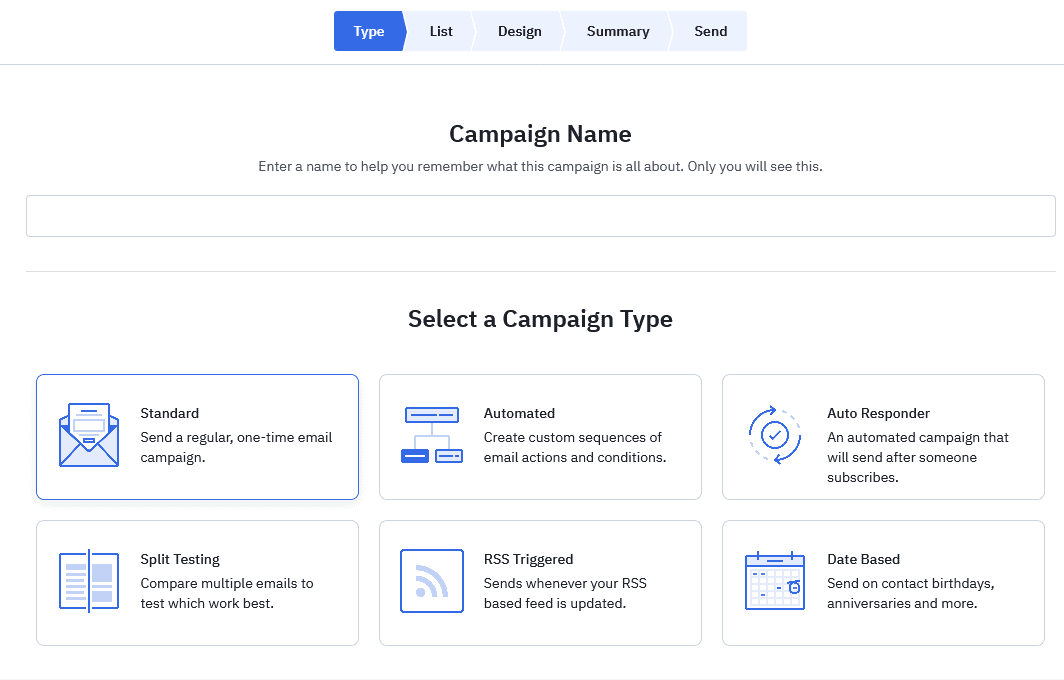
There are 125+ email templates to choose from, but you can always start from scratch, or use a very minimal template if you like. If you care about making sure the design matches your branding as best you can manage, the near-blank starting points are good.
As for the more “designed” options, all of the options lean towards flat and modernist. They’re really simple designs that won’t get in your way but are unlikely to amaze either. Then again, this is email. You want people to be reading, not staring in awe.
Oh, and all the templates are responsive and mobile-screen-friendly. That’s a definite plus.
That said, if you want to go crazy, you can import or create custom HTML templates. If you really, really care about your style guide, you could pay someone to make a set of email templates just for you.

The actual email builder/editor is a simple drag-and-drop job, with predefined content blocks that can be added in any order you like. Colors are easily customizable, though fonts tend to be restricted, based on the template you’ve chosen. Choose wisely.
You can add text, images, buttons, videos, social links, blocks of HTML code, and even an RSS feed to your email, so you’ve got options. You can also perform simple edits, like cropping, on any images you upload. Some templates come with stock images, but there is no stock image library. It’s best to upload your own images for these things anyway.
Final notes on this: You can set the width of the email preview to see how it looks at different screen sizes. That’s good. However, support for right-to-left (RTL) languages like Hebrew and Arabic is severely limited. It only works in raw HTML blocks, or custom HTML templates, so if you want to use those languages, you’d better know a little bit of code.
That’s not entirely a deal-breaker, but it’s a strong downside for global businesses.
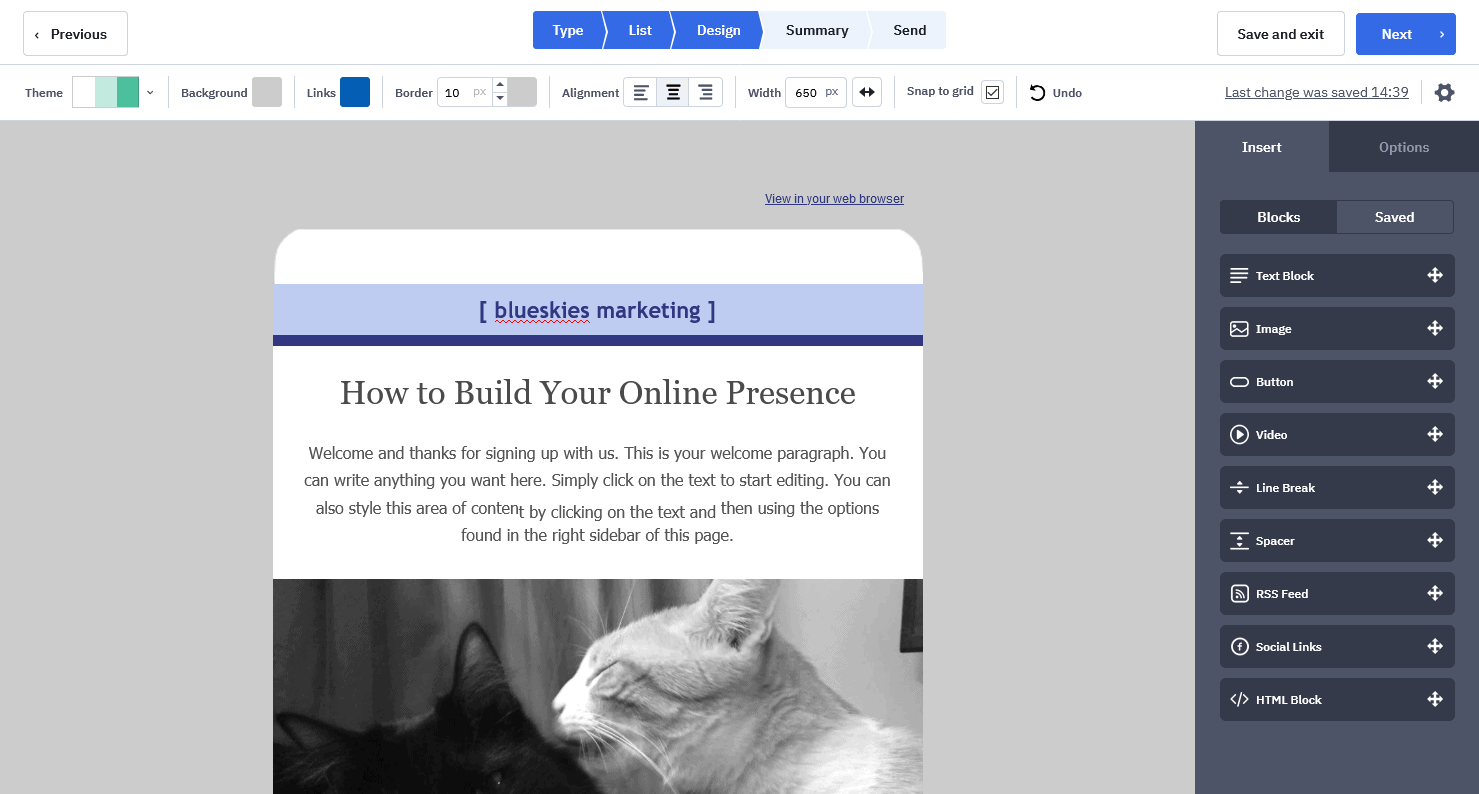
Fun fact: When subscribers click a link in an email, they can have tags added to their contact information, or removed. They can be added to a list or taken off a list. You can also add them to automation workflows (more on that below).
Email content can be personalized to an impressive degree. You can use variables to easily display information relating to the individual user. So instead of, “Hi there, person who signed up for emails,” you can use their real name in your greeting. Or at least the name they gave you.
Other variables you can use include: the contact’s address, phone number, or IP address. Also social media sharing buttons are included in this feature for some reason.
There are also conditional display tags, which allow you to show or hide different blocks of content depending on the person the email is being sent to. You can show or hide content based on tags, deals they might be interested in, when they subscribed, where they are, or what list they’re on.
A/B testing is available, in an extremely limited fashion. Simply put, A/B testing is supposed to let you send one version of an email to half the intended recipients and another version to the other half. Let’s say one has more formal writing, and the other has more bombastic infomercial-style text.
Then, you can check the statistics to see which performed better. It’s easy as pie, or easy as cleaning up pie stains with the Cleaninator 3000. (Now I wonder if there really is a product by that name.)
On ActiveCampaign, A/B testing is basically restricted to the subject lines and preview text of your emails. I wish there was more to it, but there isn’t.
Mailing Lists and Segmentation
Importing and managing your contacts is generally pretty simple, but it’s also where we see the first major flaw in ActiveCampaign’s feature set. You can type in contact information manually, collect contact information via forms, copy and paste lots of contacts in or, as you’d expect, import a file full of contacts. That’s all good, and all stuff you’d expect.
However, the only file format you can import is CSV, which is a good and common format, but it’s not enough. Nearly all online marketing services let you import contacts from a variety of formats. In addition to CSV files, every service like this should be able to import XLSX (Microsoft Excel) files, which are pretty darned standard in the industry.
So yeah, that may not seem like much, but for anyone who has to manage large numbers of contacts and pass them around in a team, the lack of XLSX support is a major blow.
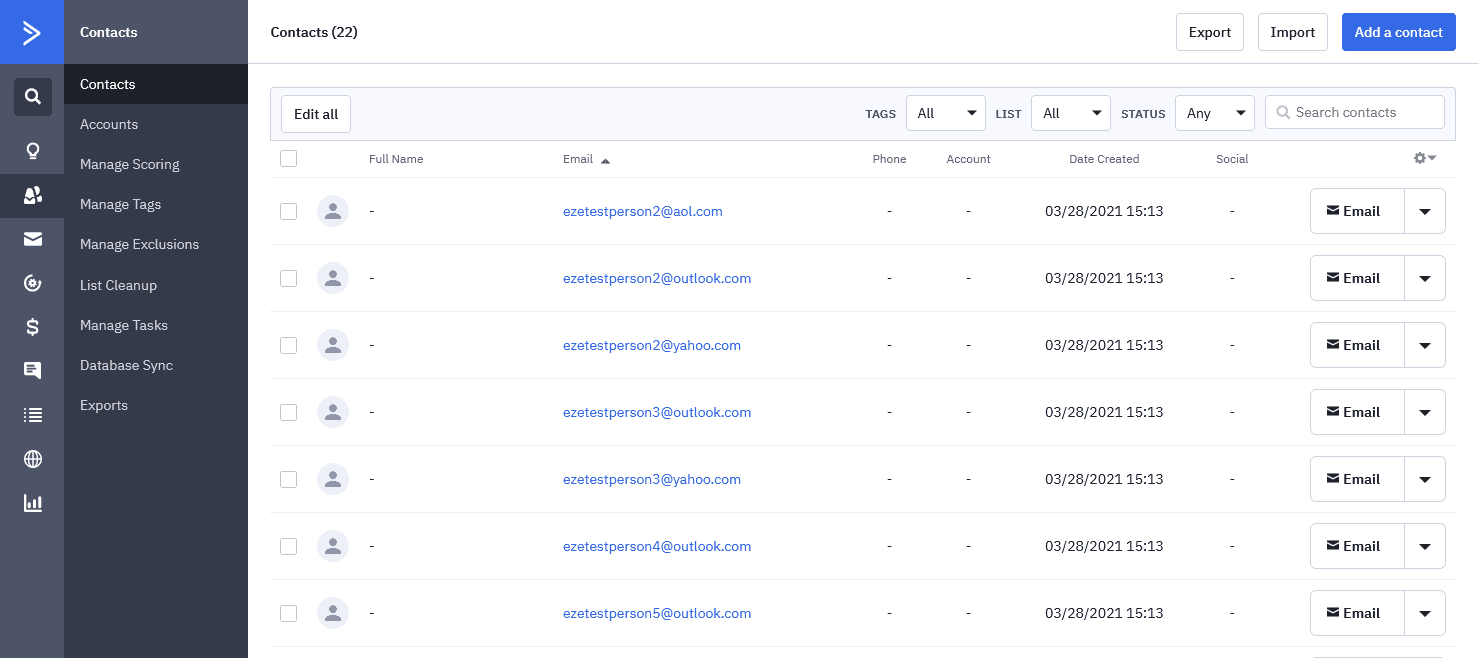
Where ActiveCampaign excels*, though, is in importing contacts from third-party services. Options include, but are certainly not limited to: 123ContactForm, Asana, Basecamp, Eventbrite, Freshbooks, Google Contacts, Google Spreadsheets, PayPal, Zapier, and Zoho CRM. You can even import contacts from database software like MySQL and PostgreSQL.
So technically, you could upload an XLSX file to Google Drive, convert it to a Google Spreadsheet, and then… well that seems like too much extra work, to be honest.
* Excels? Get it? Because… never mind.
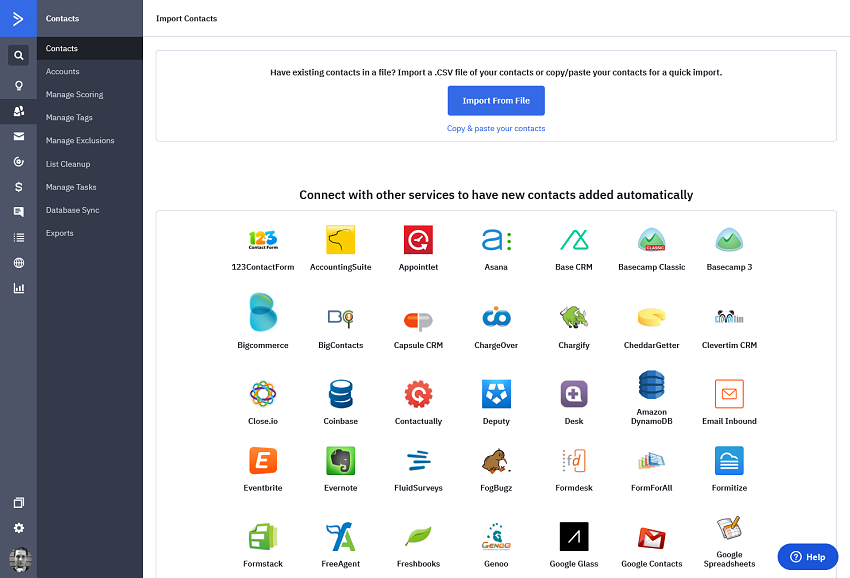
Contact lists are easy enough to create, manage, and customize. You can use them to separate your contacts into easily targetable groups and keep track of who wants which kinds of emails. These lists can also display and sort contacts by their names, emails, phone numbers, business accounts they might be attached to, and more.
You can also create custom fields to store any kind of information you want about a contact
Next up, let’s have a look at segmentation. Essentially, segmentation allows you to create lists of contacts that dynamically update themselves as conditions change. For example, if you have location information about your contacts, you could make a list of every contact in Germany who has interacted with your emails in the past year. Then, when someone new from Germany signs up and clicks a link, that list gets updated.
Well, segmentation is here, and it’s built into the advanced search function. You can just assemble an advanced search with all of the parameters you want, and save that search so you can access it whenever you want.
And you can search your contacts by anything (or at least any information you have on them): names, tags, whether they’re on a specific list, if they’ve opened an email in the last week/month/year, or clicked on a specific link. Mix and match those parameters as you will to find the contacts you want to follow up on or track.
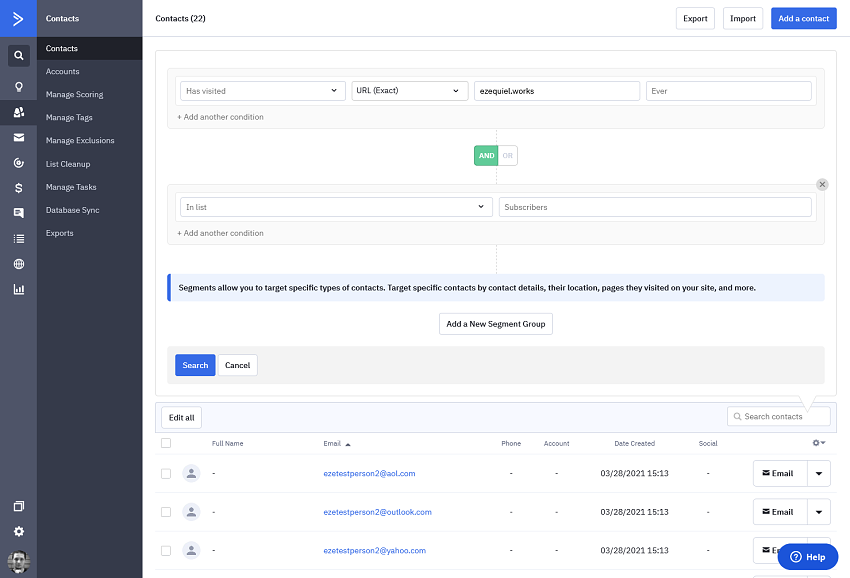
There is also a handy list cleanup feature, to make sure your contact lists only contain people who are engaged with your emails. Simply put, you have a limited number of contacts you can send email to every month. Why waste money on people who don’t want those emails?
With a simple click, you can clear out all contacts who have unsubscribed, have not confirmed their subscriptions, or had emails to their account bounce right back. Weirdly, you can also clear out active email readers. Not sure why, but I’m sure there’s a use-case somewhere.
Side note: You can set a date for clearing out contacts who haven’t opened one of your emails in a while. So you can clean up your list, but still give people a chance to maybe open emails that they just haven’t gotten to yet. (What? I can be terrible about looking at emails. I just forget about them sometimes.)
Lastly, we want to take a look at suppression lists. Suppression lists are lists where you can put contacts who you don’t want to send email to – for example, people who have unsubscribed, to make sure you don’t accidentally send them emails in the future.
You can add people to a suppression list yourself, but some others will be added automatically, including people who unsubscribe and people who mark your email as spam with their email provider.
For obvious reasons of privacy and compliance with laws, ActiveCampaign won’t tell you who marked your emails as spam. Best if you just forget all about those people, and try to make the contacts you still have as happy as you can.
Landing Pages
There is a landing page builder, and I found it to be pretty good. Unfortunately, landing pages are only available on the Plus plan and up, though you can try them out during your free trial of ActiveCampaign.
There are over 40 landing page templates, and they’re all pretty good-looking. Some are minimalist, while others are far more vibrant and fancy. Truth be told, I think the landing page templates are more compelling than the email templates.

While the landing page builder looks rather different from the email builder, they work on essentially the same principle. You drag and drop different pre-designed content blocks around the page until you’re happy. There does seem to be more layout flexibility in the landing page builder, and that’s a good thing.
The designs are all mobile-responsive, though again, there doesn’t seem to be any support for right-to-left languages. A bit of a shame, but not a deal-breaker for everyone.

Lastly, a couple more good things: There are no limits on the number of landing pages you can make. Just go ahead and make a ton.
Also, you can connect your own custom domain, so landing pages will look like they’re a part of your existing website. Having these pages under the same domain as your main site can do a lot to promote trust and reduce confusion amongst your contacts and customers, so it’s a great feature.
Automation
Automation is such a fantastic, practical invention. How? Let’s imagine, nevertheless, that you have two contact lists. While some people joined up for industry news, others did so for offers. What if you wanted to discreetly announce your agreement to every member of the industry news list?
To that one can respond, “Click here to complete an additional form and receive the best prices on services in the taco-making industry!” However, that would frustrate and take up time for the reader. By the time they saw the words “another form,” a lot of people would give up on the procedure. Thus, refrain from doing it. There is an improved method.
ActiveCampaign’s automation tools allow you to easily define a process that happens, well, automatically. For example, you could have a link that says, “Want to find the best deals on leashes and other dog-walking supplies? Sign up instantly!” That last part could even be a CTA button.
A landing page with the message, “Thank you, you’ll be getting the best deals now,” would then be shown to those who clicked on that link. The reader’s email address will be added to your list of contacts in ActiveCampaign who will get emails about specials. You might also automatically send a confirmation email in the interim saying something like, “It’s fantastic to have you! Next week, you’ll receive your first email regarding offers. In case you accidentally signed up, follow these instructions to unsubscribe.
As long as your automation workflow is in place, all of this can happen without you having to do anything. Need yet more illustration? In the automation editor, an email with the subject line “reminder to repurchase stock” looks like this:
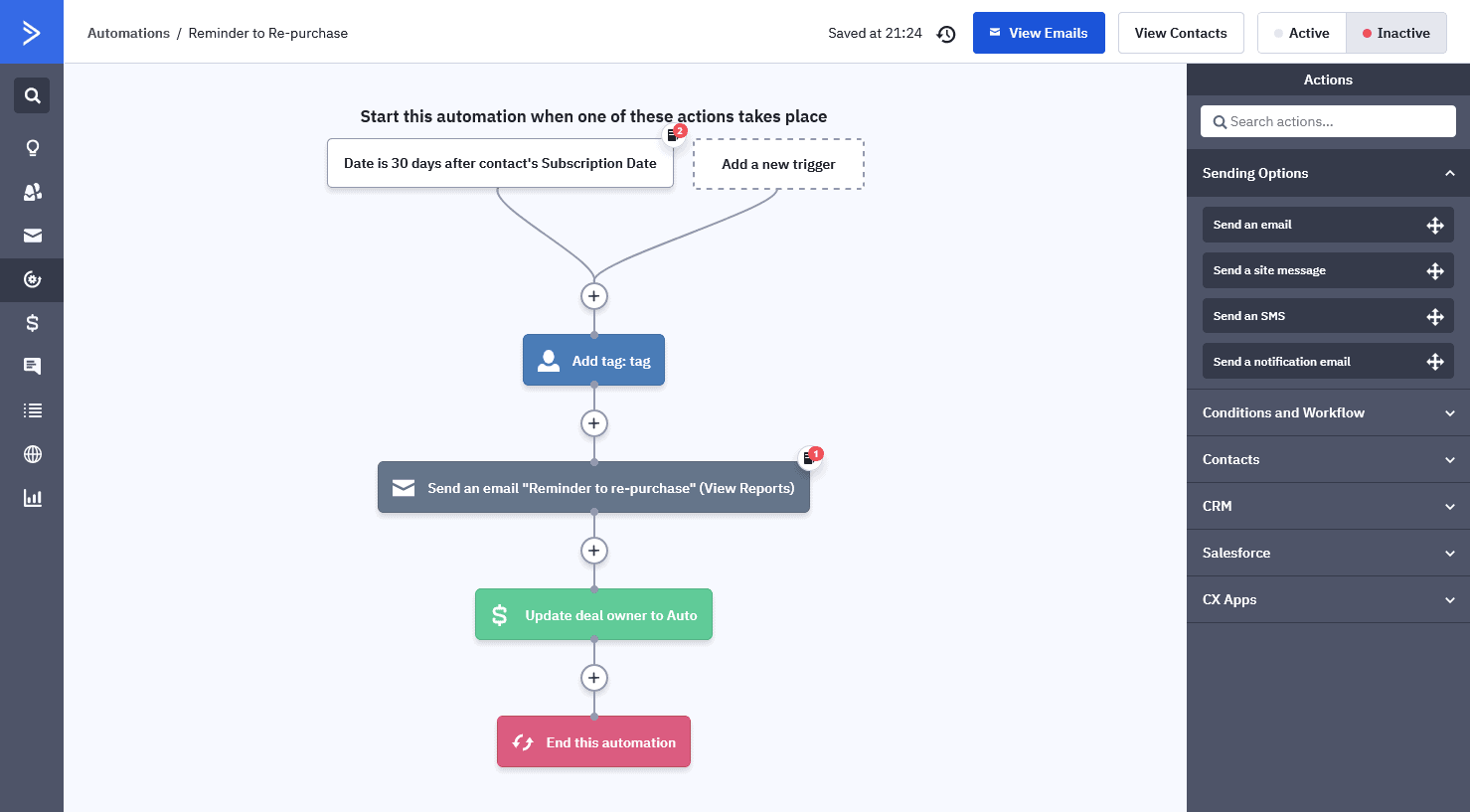
If you don’t want to design a process from scratch, there are over 250 automation templates (plus duplicates in different languages) including: abandoned cart email notifications, targeted follow-up emails, tagging customers interested in specific products, and so many more.
The interface for automation is sophisticated and adaptable. Other ActiveCampaign users’ automation recipes can be imported by you as well as shared. Considering that ActiveCampaign has a sizable community, that can save you a ton of effort.
It should be mentioned that some capabilities, such as SMS-based automated workflows, are only available with more expensive contracts.
Additional Features
I’d like to go over some of the features that aren’t strictly email-related, but still incredibly useful:
For one, there’s a live chat feature. That is to say, ActiveCampaign offers a live chatbox that you can integrate into your own website, to talk to your potential customers. Use it for sales, customer support, or whatever else you like, and it should all be easy enough to track with the…
Unified inbox! This is a feature that allows you to keep track of every interaction with every customer, whether they wrote back to one of your emails (provided you allow that) or used the chatbox to get a hold of you.
Keep in mind that both of the aforementioned features fall under “Conversations,” which is actually an add-on feature for ActiveCampaign. In other words, you’ll need to pay for it separately.
Now, something for which you don’t have to pay extra is the library of third-party add-ons and integrations. There are, let’s see, how do I put this…? Too many of them? Is 850+ add-on apps too many? Well, not if you find all the ones you want, I guess.
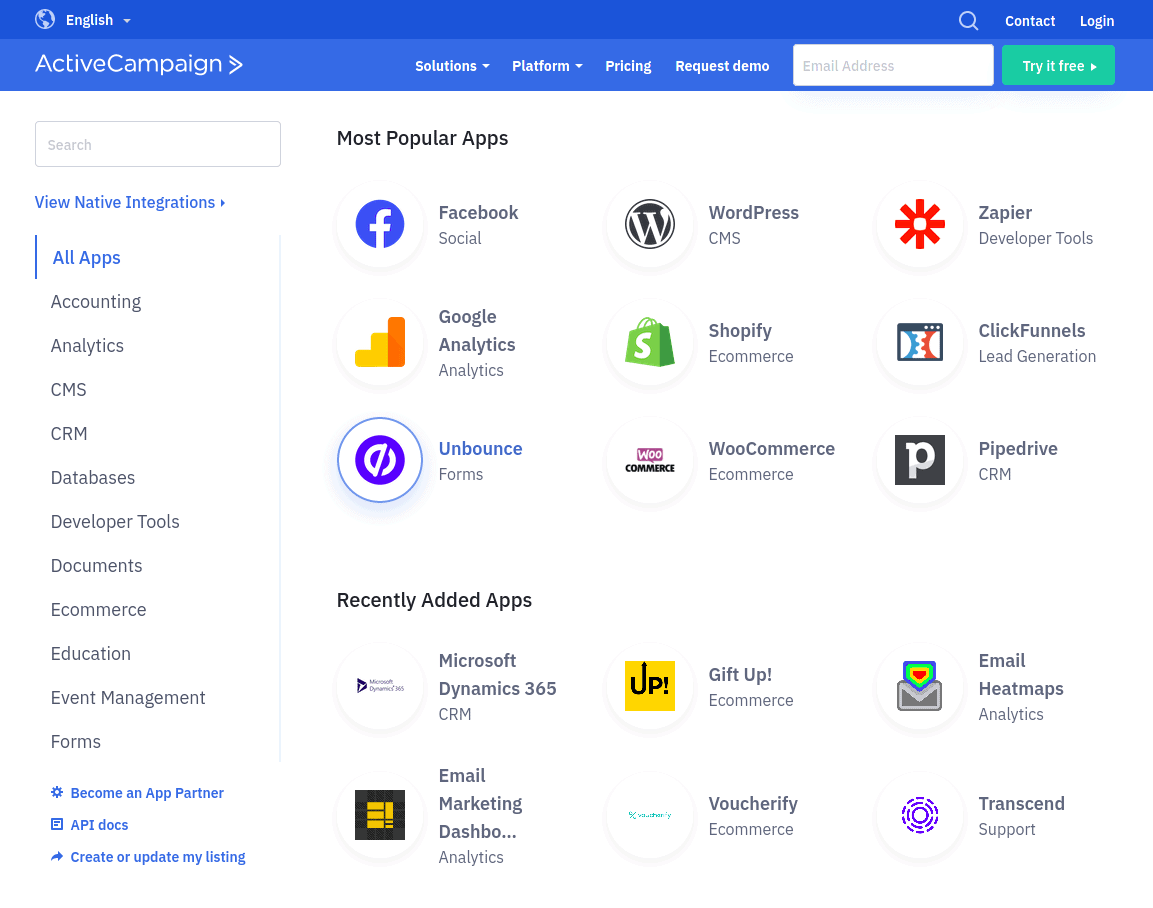
These apps include things like Google Analytics, WordPress, Shopify, WooCommerce, AccessAlly, Airtable, GitLab, Hootsuite, and a ton that I’ve never even heard of. Man, the people who make online services for business have been busy.
4.5
DELIVERABILITY
Your Email Has a Better-Than-Decent Chance of Getting to Its Destination
So, some systems of evaluating email deliverability will try to quantify the results. As in, they’ll tell you that ActiveCampaign (or any other company) has a 67% deliverability rating or something like that.
Thing is, it’s more or less impossible to test all of the variables involved in getting an email from point A to point B. It’d almost be easier to predict the odds of your mailman delivering your bills, ads, and coupons on time. (Almost.)
The best anyone can reasonably do (and this is our approach here at Website Planet) is to look at a few basic features that can help improve your odds. The score at the bottom of this section is not a deliverability rating, only a measure of how ActiveCampaign’s features compare to those of other services.
First, we check to see if there’s an easy way to make use of DKIM authentication. Okay, I’ll skip the nerd talk, and just say this: it involves encryption, and it’s used to help the services that receive your emails to know that your email comes from you. It’s not a guarantee that your emails will get through, but it can help.
ActiveCampaign does have DKIM authentication, and there’s an easy guide you can follow in the help center. If you have your own domain name, I’d highly recommend using this method to improve your odds of getting the mail through.
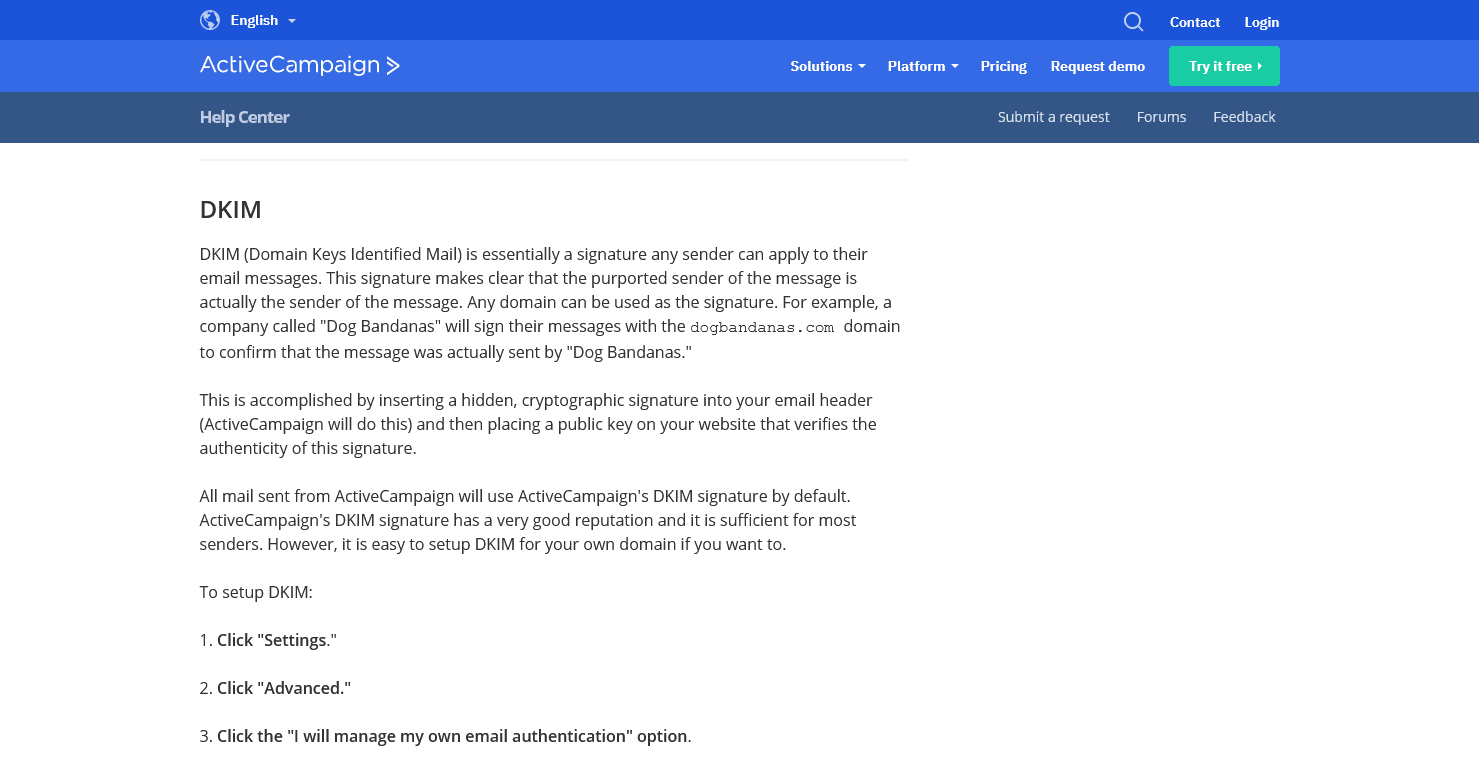
Next up, we look at the anti-spam policy. Marketing email campaigns that people have signed up for are one thing. Straight-up spam is another. Any email marketing platform that allows spammers to thrive is going to cost you business because those spammers will make your emails look bad too.
ActiveCampaign takes spam pretty seriously, but could perhaps be a little harsher. You’ll see what I mean. The basic policy is actually pretty great:
- All subscribers/contacts must be opt-in. As in, they all must have agreed to receive your emails.
- Your account WILL be penalized or shut down if you’re caught sending spam.
- Accounts can be put under review for having a bounce rate that’s too high, a high unsubscription rate, and of course, a high complaint rate.
In practice, there could be more safeguards upfront, before anyone starts sending out emails. One of the tests I run on every service is a simple filter test. That is, I upload the emails of a ton of known spammers, and generally suspicious addresses, to see if those addresses get rejected.
Competitors like GetResponse have passed this filter test. ActiveCampaign, I am sad to say, did not. I was able to import these spam emails without a problem.
Now, how about affiliate marketing? Some email services allow you to link to other people’s products as part of an affiliate program, and others will straight up block those emails from going out. Or at least put your account under review. Where does ActiveCampaign stand on that?
Simply put, affiliate links are permitted, with some restrictions:
- You cannot use ActiveCampaign to run your own affiliate programs.
- Affiliate links should, as per the guidelines, not be the primary focus of the email.
- You can’t send emails with the sole purpose of promoting a product or service that’s not yours.
- No get-rich-quick or make-money-from-home schemes. Doesn’t matter if you include an affiliate link or not. This is a rule I completely agree with.
Lastly, for this set of features, you can get a private (AKA dedicated) IP address from which to send your emails. Sort of. So here’s how this works, in theory: If your emails are coming from the same IP address as spam, the whole IP address could get flagged by email providers. That means your emails go off into the void along with pure spam.
Also, when emails always come from the same IP address (or range of IP addresses), that signals to services that receive email that it’s more trustworthy. At the very least, it’s more likely that all of your company emails are actually coming from your company.
That way, when an email that’s supposed to be from you is sent from a different IP address, then Gmail (or whatever company) knows it’s likely to be spam. You don’t strictly need to buy your own dedicated IP. All the big email companies have relatively trusted IP addresses of their own.
But having a dedicated IP can help your emails to get through. That’s why it’s somewhat annoying that most ActiveCampaign customers will likely never get one. See, dedicated IPs are available for purchase from ActiveCampaign, but only if you have 100,000 opted-in and regularly engaged contacts. This means you’re literally an enterprise customer, paying prices beyond those listed on ActiveCampaign’s pricing page.
At that point, you may as well have your own server, complete with dedicated IP, and just have someone run a self-hosted email marketing platform for you. Could be cheaper.
4.7
ANALYTICS & REPORTING
ActiveCampaign Has Pretty Detailed Statistics and Reports
Statistics are one of the cornerstones of marketing. The others are, presumably, a general knowledge of things people want to buy, the ability to write in plain English (or whatever language you’re using), and an array of acronyms that only insiders understand.
But now, we need to look at the numbers. The best email analytics will help you figure out who is responding best to your email campaigns, and how you can repeat your successes. They also help you figure out what isn’t working, so you can try something else.
Simply put, you need the numbers. The more detailed, the better.
Well, ActiveCampaign generates reports on email campaigns, automation workflows, contacts, and even self-defined goals. That’s right, you can set goals in the admin interface, and get reports on whether or not you’ve met them.
The email campaign reports will tell you not only how many people opened your emails and clicked links in them, but how many forwarded your emails on, unsubscribed, or whatever else. And, most importantly, they’ll tell you who opened your emails, and who clicked the links, and so on.
That’s the kind of information you need to draw insights and create a strategy.
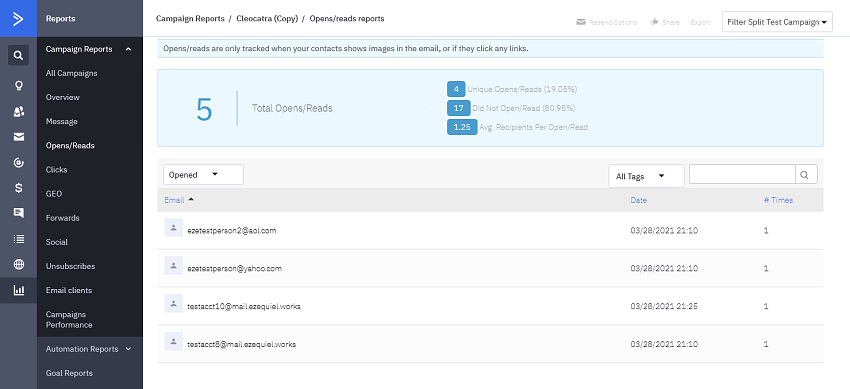
Now, if you want to break down those results by where your contacts come from, for example, you’ll need to have collected the location of all your contacts upfront. That kind of information doesn’t magically just appear in your analytics.
That said, ActiveCampaign can and does show daily and hourly engagement trends. Want to know what time of day people actually open your emails and click on the links? Well, here you go.

I’m quite satisfied with the reports and analytics overall. There are enough details and insights to work with… or at least to get started with. For the really detailed stuff, you’ll need to actively find out more about your customers.
But hey, that’s Marketing 101, ain’t it?
4.7
SUPPORT
Support Is Prompt and Mostly Helpful, Even Outside of Business Hours
I am the kind of individual who engages in writing during the nocturnal hours, as my unfaithful brain has concluded that this timeframe is optimal for engaging in creative tasks. Consequently, I have experienced the chance to evaluate ActiveCampaign’s support team at both its peak performance and its most challenging moments.
I put quotes around “worst” for a reason. While not every answer I got was entirely satisfactory to me, the staff were quick to respond and did their best to be helpful. I can hardly complain.
The primary support channels are phone, live chat, and email. Now, I had to actually search the knowledge base to figure out what the schedule was for the live chat, and I still haven’t found exact hours for the phone support (so I called them and asked).
Anyway, email support is available 24/7, and live chat is available on:
- Monday – Thursday from 8 AM – 11 PM, Central Standard Time
- Friday from 8 AM – 6 PM, Central Standard Time
Phone support is from 8 AM – 5 PM. Again, that’s Central time.
In addition to those primary support channels, there’s a pretty in-depth knowledge base. There’s an “Education Center” that has full-on courses in how to use ActiveCampaign, and then there’s community support. I do love a good classic web forum.
Anyway, here’s how my experience went:
Live Chat
I wrote in specifically to ask, “Would it be possible to achieve RTL language support (e.g. Arabic or Hebrew) in email campaigns with a custom HTML template?”
Well, it took a little more explaining, but the whole interaction took less than ten minutes, and I got the answer I was hoping for: Yes, you can use a custom HTML template to support RTL languages.
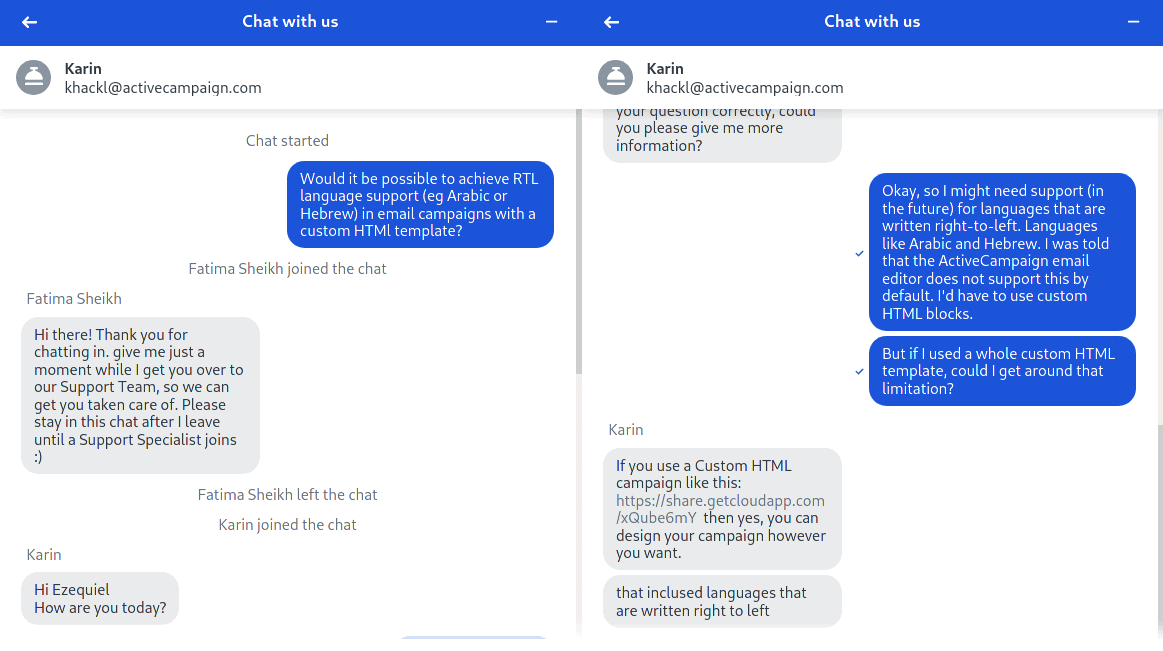
Phone
So honestly, I called to ask about an apparent bug on the pricing page. See, there’s a slider that lets you say how many contacts you have, and the prices on the plans change to account for the size of your contact list. However, when you move that slider high enough, it just stops showing prices. Like so:

Well, I called up support first thing in the morning. They answered quickly, and I got my answer very fast. Simply put, those blank prices mean, “Call the sales team, because we are way beyond ‘sliders’ here.” Or, to put it more technically, at that level, the pricing has to be more flexible based on what you want.
The agent I talked to was polite and helpful, and the whole experience was smooth. Nothing to complain about here.
I sent an email via the form on the site (very late at night), asking if there was a way to build a website with the page builder. As in, could I attach my domain, designate one page as my “homepage” and go from there?
The answer was helpful in some ways, but overall inconclusive. Specifically, the tech never responded to the question about designating a homepage to build a proper website. This leads me to believe it’s not quite possible.
I just wish the response had been a little clearer.
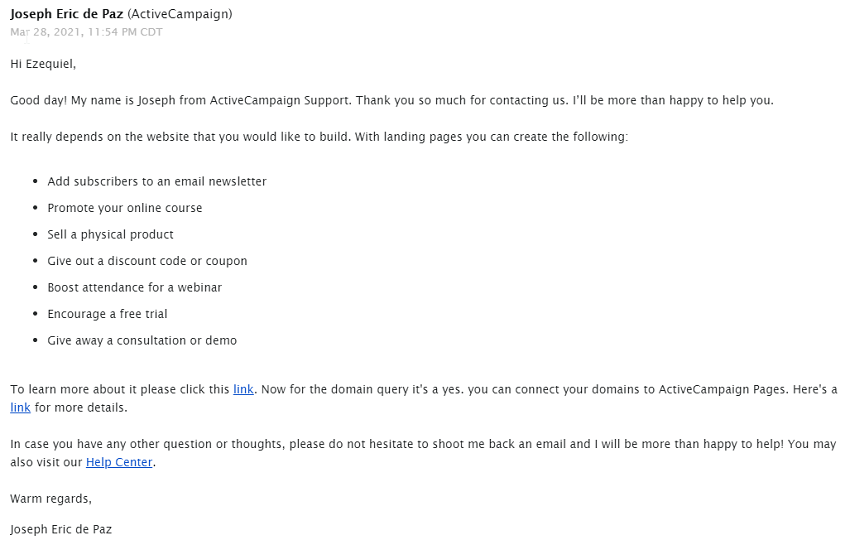
4.7
PRICING
The Prices Could Be Cheaper, but They Aren’t Bad Either
There are a variety of plans, that vary based on how many contacts you want to send email to. The plans start at 500 contacts (for $9 per month if you pay annually, or $15 if you pay monthly) and go up to 100,000 contacts (for a whole lot more).
ActiveCampaign’s cheapest plans are quite cheap, and good value for the features you can get – we’ve done a whole deep dive into ActiveCampaign’s pricing if you’re really interested. However, once your contact list begins to expand, you’d better be making money off your email campaigns, because those higher-tier plans are pricey indeed. In fact, on the more expensive plans, the website may not even show you prices. You’ll be expected to talk directly to sales about spending that kind of money.
That said, there is a 14-day free trial, no credit card required. You can evaluate most of the features at your leisure, so long as your leisure only lasts about two weeks.
At the end of the day, there are no refunds.
You can pay monthly via MasterCard, Visa, or American Express. If you pay the yearly price, you can also pay by PayPal, wire transfer, or check.
ACTIVECAMPAIGN REVIEW: BOTTOM LINE
The feature-rich plans offered by ActiveCampaign can be a good fit for your email marketing requirements. There aren’t many “glaring” issues, and ActiveCampaign is a great option if you’re looking for a service that can be integrated with nearly any toolchain.
However, the rather exorbitant costs on more premium plans may let this respectable feature set down. It seems foolish to lock dedicated IPs away from those who don’t have more than 100,000 contacts, and Excel file importation is a must.
Having said that, most customers will receive somewhat greater value at Sendinblue (which also offers a free subscription) or GetResponse. However, if you think that ActiveCampaign’s specific feature set is what you need, go ahead and it. I certainly won’t judge you.
FAQ
Is ActiveCampaign a good email marketing service?
ActiveCampaign is one of our top choices for email marketing services, as it has hundreds of beautifully designed templates, visual automation maps, and it’s suitable whatever your experience is with email marketing. If you’re a beginner, you can take advantage of its 14-day free trial. In addition to email marketing, it has powerful sales automation features and integrations with over 300 apps.
What does ActiveCampaign do?
A platform for automating customer experiences is called ActiveCampaign. It features automated workflows to save you time, CRM capabilities to assist in building relationships, email marketing to help you engage with and nurture subscribers, and e-commerce solutions to help you make money. Make sure to take a look at our email marketing coupons if you’d like to give it a try and save some cash on an ActiveCampaign plan.
Why should I use ActiveCampaign?
The ideal platform for expert marketers looking to use machine learning and want sophisticated automation tools is ActiveCampaign. Because it contains e-commerce capabilities, win probability, and lead scoring, it’s also a wise option for working with sales teams.
Is ActiveCampaign easy to use?
ActiveCampaign is easy to use, as the interface is intuitive, making the navigation simple. The platform has hundreds of templates that you can use for email campaigns and marketing automations, and the drag-and-drop editor is a breeze to learn. It also has easily accessible tutorials and guides to help you.




